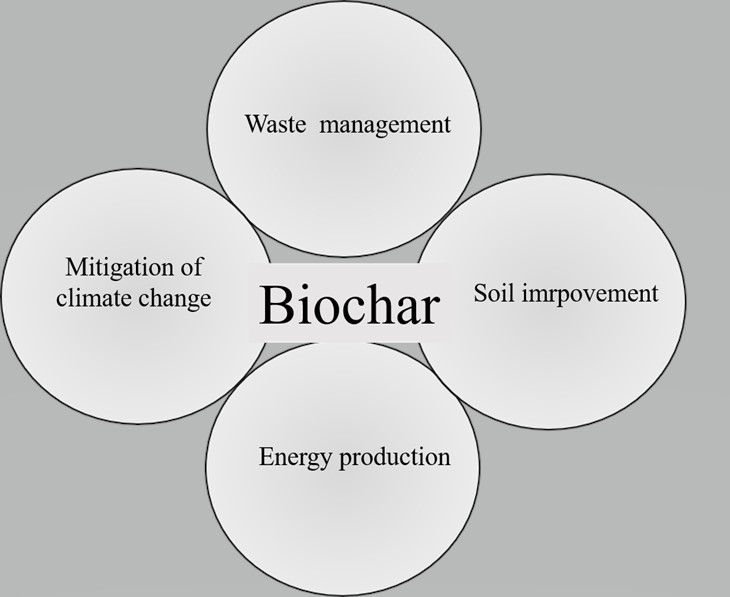Potential of biochar after the biological activation by native soil microflora
Potencial de biocarbón después de su activación biológica por microflora nativa del suelo

Show authors biography
Objective. Dehydrogenase activity after the biological activation of biochar by the native soil microorganisms was studied. The main aim was to improve biochar properties by activation and make it more friendly for the soil microflora. Materials and methods. The activation was reached by aerating with the soil solution for two weeks. No special inoculum of microorganisms was applied. The following treatments in four replicates were prepared: conventional raw biochar (BR), activated biochar (BA), mineral fertilizer DAM 390 (NF), and control (C). A statistical test for comparing treatments means (Fisher p≤0.05; program STATISTICA 12.0; StatSoft software Inc., Tulsa, Oklahoma, USA) was used. Results. Statistically significant differences in the dehydrogenase activity between the treatments BR, BA, and C were found. Application of mineral fertilizers had a negative effect and increasing of nitrogen leaching was observed. Conclusions. Activating of biochar is suitable metods for impove soil biota conition compared with convention biochar.
Article visits 795 | PDF visits
Downloads
- Lehmann J, Rillig MC, Thies J, Masiello CA, Hockaday WC, Crowley D. Biochar effects on soil biota–a review. Soil biology and biochemistry. 2013; 43(9):1812-1836. https://doi.org/10.1016/j.soilbio.2011.04.022
- Zhang C, Nie S, Liang J, Zeng G, Wu H, Hua S. Effects of heavy metals and soil physicochemical properties on wetland soil microbial biomass and bacterial community structure. Science of the Total Environment. 2016; 557:785-790. https://doi.org/10.1016/j.scitotenv.2016.01.170
- Quilliam RS, Glanville HC, Wade SC, Jones DL. Life in the ‘charosphere’–Does biochar in agricultural soil provide a significant habitat for microorganisms?. Soil Biol Biochem. 2013; 65:287-293. https://doi.org/10.1016/j.soilbio.2013.06.004
- Sorrenti G, Masiello CA, Dugan B, Toselli M. Biochar physico-chemical properties as affected by environmental exposure. Science of the total Environment. 2016; 563:237-246. https://doi.org/10.1016/j.scitotenv.2016.03.245
- Wang B, Jiang YS, Li FY, Yang DY. Preparation of biochar by simultaneous carbonization, magnetization and activation for norfloxacin removal in water. Bioresour Technol. 2017; 233:159-165. https://doi.org/10.1016/j.biortech.2017.02.103
- Sajjadi B, Zubatiuk T, Leszczynska D, Leszczynski J, Chen WY. Chemical activation of biochar for energy and environmental applications: a comprehensive review. Rev Chem Eng. 2019; 35(7):777-815. https://doi.org/10.1515/revce-2018-0003
- Wolińska A, Stępniewska Z, Bielecka A, Ciepielski J. Bioelectricity production from soil using microbial fuel cells. Appl Biochem Biotechnol. 2014; 173(8):2287-2296. https://doi.org/10.1007/s12010-014-1034-8
- IUSS Working Group WRB. World reference base for soil resources 2014, update 2015: International soil classification system for naming soils and creating legends for soil maps. Reports No. 106. World Soil Resources; 2015. http://www.fao.org/3/i3794en/I3794en.pdf
- Sato JH, Figueiredo CCD, Marchão RL, Madari BE, Benedito LEC, Busato JG, Souza DMD. Methods of soil organic carbon determination in Brazilian savannah soils. Scientia Agricola. 2014; 71(4):302-308. http://dx.doi.org/10.1590/0103-9016-2013-0306
- Pospíšilová H, Jiskrova E, Vojta P, Mrizova K, Kokáš F, Čudejková MM, Dzurova L. Transgenic barley overexpressing a cytokinin dehydrogenase gene shows greater tolerance to drought stress. N Biotechnol. 2016; 33(5):692-705. https://doi.org/10.1016/j.nbt.2015.12.005
- Kučerík J, Tokarski D, Demyan MS, Merbach I, Siewert CC. Linking soil organic matter thermal stability with contents of clay, bound water, organic carbon and nitrogen. Geoderma. 2018; 316:38-46. https://doi.org/10.1016/j.geoderma.2017.12.001
- José M, Paneque M, Miller AZ, Knicker H. Relating physical and chemical properties of four different biochars and their application rate to biomass production of Lolium perenne on a Calcic Cambisol during a pot experiment of 79 days. Sci Total Environ. 2014; 499:175-184. https://doi.org/10.1016/j.scitotenv.2014.08.025
- Casida LE, Klein DA, Santoro T. Soil dehydrogenase activity. Soil Science. 1964; 98:371-376
- Peoples MB, Faizah AW, Rerkasem B, Herridge DF. Methods for evaluating nitrogen fixation by nodulated legumes in the field (No. 435-2016-33692). 1989
- Keeney DR, Nelson DW. Nitrogen—inorganic forms. Methods of Soil Analysis: Part 2 Chemical and Microbiological Properties. American Society of Agronomy. 1983. https://doi.org/10.2134/agronmonogr9.2.2ed.c33
- Pittelkow CM, Linquist BA, Lundy ME, Liang X, van Groenigen KJ, Leevan Kessel C. When does no-till yield more? A global meta-analysis. Field Crops Research. 2015; 183:156-168. https://doi.org/10.1016/j.fcr.2015.07.020
- Pauli N, Abbott LK, Negrete-Yankelevich S, Andrés P. Farmers’ knowledge and use of soil fauna in agriculture: a worldwide review. Ecology and Society. 2016; 21(3):19. https://www.jstor.org/stable/26269977
- Chebotarev NT, Yudin AA, Konkin PI, Oblizov AV. Efficiency of using organic and mineral fertilizers in fodder crop rotation on northern soddy podzols. Russian Agricultural Sciences. 2017; 43(2):162-166. https://doi.org/10.3103/S1068367417020045
- Kučová L, Záhora J, Pokluda R. Effect of mycorrhizal inoculation of leek Allium porrum L. on mineral nitrogen leaching. Horticultural Science. 2016; 43(4):195-202. https://doi.org/10.17221/182/2015-HORTSCI
- Kuzyakov Y, Bogomolova I, Glaser B. Biochar stability in soil: decomposition during eight years and transformation as assessed by compound-specific 14C analysis. Soil Biol Biochem. 2014; 70:229-236. https://doi.org/10.1016/j.soilbio.2013.12.021
- Major J, Rondon M, Molina D, Riha SJ, Lehmann J. Maize yield and nutrition during 4 years after biochar application to a Colombian savanna oxisol. Plant Soil. 2010; 333(1-2):117-128. https://doi.org/10.1007/s11104-010-0327-0
- Xu N, Tan G, Wang H, Gai X. Effect of biochar additions to soil on nitrogen leaching, microbial biomass and bacterial community structure. Eur J Soil Biol. 2016; 74:1-8. https://doi.org/10.1016/j.ejsobi.2016.02.004
- Di HJ, Cameron KC. Inhibition of nitrification to mitigate nitrate leaching and nitrous oxide emissions in grazed grassland: a review. J Soils Sediments. 2016; 16(5):1401-1420. https://doi.org/10.1007/s11368-016-1403-8
- Geisseler D, Scow KM. Long-term effects of mineral fertilizers on soil microorganisms–A review. Soil Biol Biochem. 2014; 75:54-63. https://doi.org/10.1016/j.soilbio.2014.03.023
- Morriën E. Understanding soil food web dynamics, how close do we get?. Soil Biol Biochem. 2016; 102:10-13. https://doi.org/10.1016/j.soilbio.2016.06.022























